Introduction of Indonesian Fine Coffee beans introduction of Manor Flavor in Manning Fine Coffee producing area
Java is Indonesia's most economically developed island and the most densely populated region.
Jakarta, the capital of Indonesia, is located in the northwest of Java Island and is the largest city in Southeast Asia. In addition, Indonesia's second and fourth largest cities are located on Java Island.
Java was the first region in Indonesia to grow coffee and dominated the world coffee market as early as the 18th century. The famous Javanese mocha, a blend of Javanese coffee and Yemeni mocha, represents an era of coffee impressions. In addition, there is classic monsoon coffee Moosooned-coffee, or aged coffee.
Coffee cultivation on Java Island was initially carried out on large farms, established by Dutch colonists in the 18th century, and gradually transformed into small farmers through World War II and many changes. Good Java coffee usually comes from five existing large farms. Although Java coffee production accounts for only about 10% of Indonesia's total coffee production, it is an important component of Indonesia's fine coffee.
The main coffee producing area of the island is located in the Ijen Plateau, in the Ijen Highlands region around Ijen Volcano.
Java coffee is traditionally processed by washing Sulawesi, formerly known as Celebes, hence Sulawesi coffee is also known as Celebes Coffee.
The most famous is Toraja, or Tornaga, Toraja.
Toraja coffee is produced in Tana Toraja district of South Sulawesi province, named after the local Toraga people. Tana Toraja is located about 300 kilometers north of Makassar, the provincial capital, and is a well-known tourist destination in Indonesia.
Initially Sulawesi coffee industry mainly supplies the Japanese market, Japanese businessmen established the initial coffee industry in Sulawesi Island.
The traditional coffee processing method is wet planing, Giling Basah, wet-hulled Sumatra Island, formerly known as "Golden Island","Golden Island", known for its rich gold deposits.
Sumatra has a long and narrow terrain, mainly the Barisan Mountains and the eastern lowlands from northwest to southeast. The mountains stretch out, with more than 90 volcanoes and numerous volcanic lakes that provide fertile soil for coffee to grow. For tropical rain forest climate, high temperature and rainy all year round.
Sumatra is Indonesia's largest coffee producing area, well-known coffee growing areas are mainly concentrated in the northern mountains, including Aceh, the northernmost province, Sumatera Utara, North Sumatra. These include Mandheling, Lintong and Gayo Mountain.
Mandheling coffee is named after the local ethnic group, mantailing, and the production area mostly points to the northern mountains of Toba Lake. The specific production area needs to be verified.
Lintong coffee is produced in the foothills of Lake Toba, the largest volcanic lake in North Sumatra Province and Sumatra Island. The name comes from the town named lintong southwest of Lake Toba.
Gayo mountain coffee is produced in Takengon and the surrounding mountains of Lake Tawar in Takengon, Aceh Province.
Medan Medan and Padang are important cities involved in coffee. They are the provincial capitals of North Sumatra and West Sumatra respectively. They are also the most densely populated areas in Sumatra Island. The former is an important distribution center for Sumatra coffee exports, while the latter is surrounded by well-known coffee production, such as Ankola.

Important Notice :
前街咖啡 FrontStreet Coffee has moved to new addredd:
FrontStreet Coffee Address: 315,Donghua East Road,GuangZhou
Tel:020 38364473
- Prev

Taste of Ecuadorian Coffee introduction to Galapagos Coffee in Manor area
St. Cristobal is a larger island in the Galapagos archipelago. At 410m above sea level, there is a small lake called El.Junco, which forms streams along the rocks and volcanic rocks on the southern slope of the island. Mineral-rich fresh water moistens the land of St. Cristobal, keeping the soil moist and fertile. For here.
- Next

Panamanian coffee flavor and taste the characteristics of the manor producing area introduce Panamanian boutique coffee beans
Feicui Manor is famous for its Geisha variety. Rose summer seeds were discovered in the rose summer forests of Ethiopia in 1931 and sent to the Coffee Institute in Kenya, and then introduced to Uganda, Tanzania and Costa Rica, all mediocre. It was not until it was transplanted to Panama in the 1960s that it became a blockbuster after nearly half a century. 2005, 2006 and 2007
Related
- Detailed explanation of Jadeite planting Land in Panamanian Jadeite Manor introduction to the grading system of Jadeite competitive bidding, Red bid, Green bid and Rose Summer
- Story of Coffee planting in Brenka region of Costa Rica Stonehenge Manor anaerobic heavy honey treatment of flavor mouth
- What's on the barrel of Blue Mountain Coffee beans?
- Can American coffee also pull flowers? How to use hot American style to pull out a good-looking pattern?
- Can you make a cold extract with coffee beans? What is the right proportion for cold-extracted coffee formula?
- Indonesian PWN Gold Mandrine Coffee Origin Features Flavor How to Chong? Mandolin coffee is American.
- A brief introduction to the flavor characteristics of Brazilian yellow bourbon coffee beans
- What is the effect of different water quality on the flavor of cold-extracted coffee? What kind of water is best for brewing coffee?
- Why do you think of Rose Summer whenever you mention Panamanian coffee?
- Introduction to the characteristics of authentic blue mountain coffee bean producing areas? What is the CIB Coffee Authority in Jamaica?

